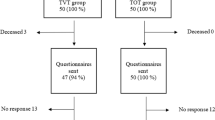Abstract
The tension-free vaginal tape (TVT) is a well-established surgical procedure for the treatment of female urinary stress incontinence. Midurethral position was thought not to be necessary to achieve continence. But in our study, a patient with stress urinary incontinence was treated with a TVT suburethral sling. The symptoms of stress urinary incontinence still exist after the TVT procedure. With physical treatment and anti-inflammatory treatment, no relief was found. At the 50-day follow-up, the symptoms of stress incontinence worsened. Transperineal three-dimensional ultrasound revealed that the sling migrated from the midurethra to the bladder neck. With adjustment of the sling, the symptom of stress incontinence was improved and no complication was observed at the 6- and 12-month follow-up. Sling migration should be considered in a patient who presents with recurrent stress incontinence at the earlier postoperative period. We think that the midurethral position is necessary to achieve continence.


Similar content being viewed by others
References
Petros PE, Ulmsten UI (1993) An integral theory and its method for the diagnosis and management of female urinary incontinence. Scand J Urol Nephrol Suppl 153:1–93
Pit MJ (2002) Rare complication of tension-free vaginal tape procedure: late intraurethral displacement and early misplacement of tape. J Urol 167:647
Sergent F, Sebban A, Verspyck E et al (2003) Pre- and postoperative complications of TVT (tension-free vaginal tape). Prog Urol 13(4):648–655
CC Ng, Lee LC et al (2005) Use of three-dimensional ultrasound scan to assess the clinical importance of midurethral placement of the tension-free vaginal tape (TVT) for treatment of incontinence. Int Urogynecol J Pelvic Floor Dysfunct 16:220–225
Delancey JOL (1994) Structural support of the urethra as it relates to stress urinary incontinence: the hammock hypothesis. Am J Obstet Gynecol 170:1713–1723
Conflicts of interest
None.
Author information
Authors and Affiliations
Corresponding author
Additional information
Statement
The content of our study had not been published or submitted for publication elsewhere. All authors who participated this study have contributed significantly, and they are in agreement with the content of the manuscript. The authors have been approved by a suitably constituted ethics committee of the institution within which the work was undertaken and that it conforms to the provisions of the Declaration of Helsinki.
Rights and permissions
About this article
Cite this article
Wang, F., Song, Y. & Huang, H. Which placement of the tension-free vaginal tape is more important for urinary continence: midurethral position or bladder neck? Consideration from a case report. Int Urogynecol J 20, 1277–1279 (2009). https://doi.org/10.1007/s00192-009-0859-0
Received:
Accepted:
Published:
Issue Date:
DOI: https://doi.org/10.1007/s00192-009-0859-0




